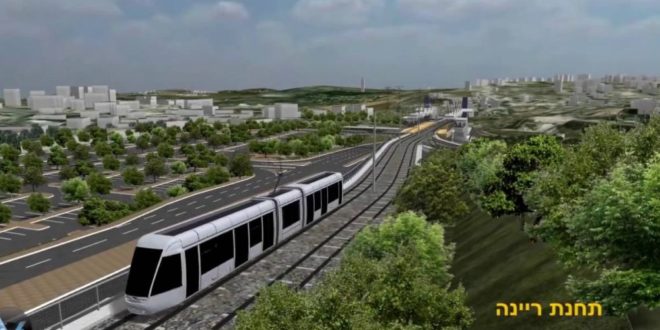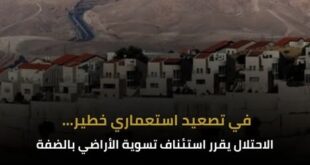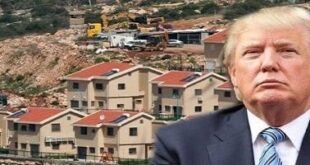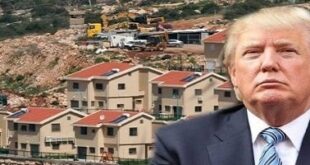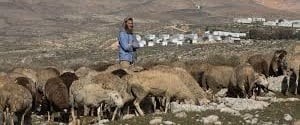By: Madeeha Araj,
The Israeli Knesset approved recently the State budget for 2019 by a majority of 62 KMs in favor and 54 against. The budget is NIS 480 billion i.e. US$ 137 billion, which means an increase by 2.6% compared to the 2018’s budget. By revising the expenses, it was noticed that budget’s items gave security the largest portion that may reach up to NIS 76 billion, distributed among the army, internal security and settlement, which significantly deepen the occupation and settlement, and prejudiced the rights of the Palestinian people. As for the Joint Arab List in the Knesset said that the budget “perpetuates the occupation , intensifies settlement, deepens discrimination and prejudices Arab citizens, widens the gaps and is unfairly distributed on the public services. The List considered the budget reveals the government’s extreme and racist policy.
The National Bureau for Defending Land and Resisting Settlements added , it is known that spending on security and settlement is not only acquired from the Ministry of Defense, but also from other ministries, especially from the budget of the Ministry of Internal Security, which is spent on the so-called border guards, which are counted as part of the police work, which is assigned to military missions in war times. The Ministry of Internal Security budget amounted to NIS 17.7 billion. Moreover, in most ministries, a budget is allocated to security and settlement as well. Several studies have shown that the total expenditure on the army, internal security, occupation and settlement is close to a quarter of the total budget.
On the other hand, Israel’s Minister of Communications, Yisrael Katz, has approved the railway and the train project, which will link Israel with the settlements, started from the RasAl-Ein town to the outskirts of the Ariel settlement through the city of Petah Tikva, which is expected to be completed by 2025 with a cost of NIS 4 billion. According to the Ministry of Communications’ resources, the railway project may end at the Za’tara Junction south of the city of Nablus. Six years ago, Minister, Katz revealed a plan for the construction of a 475 km railway networks .
It is noted that the State budget is made to be satisfied for settlers after receiving a large number of complaints from settlers in the West Bank because they don’t receive Israeli satellite communications networks, a budget has been allocated for infrastructure development and the installation of additional satellite antennas.
In the Jerusalem Governorate, the occupation authorities revealed that they are opening the first section of the “Eastern Ring Road next April, which includes the establishment of a new military checkpoint on the Essawiya east of Jerusalem. The road connects the settlements to the north of Jerusalem with east of Ramallah. The second road, which is being separated by the wall is planned to connect the northern West Bank to the south, and isolates all the land to the east as C areas. It is also said that the plan prevents the Palestinians from using all other roads that will be dedicated only to settlers, it is also an introduction to implement the E1 settlement plan.
At the same time, the Association of Israeli Contractors – the Jerusalem Brigade calls on the government to expedite the implementation settlement construction plans in the “Giv’at Hamatos” neighborhoods near Beit Safafa, and approves new building plans in the “Gilo” settlement. In both cases, there is a talk of building thousands of settlement units of which, 2600 housing units have been approved in the Beit Safafa area, about 1,700 units in the foothills of Arnona, 4,700 units in the “White Hill” – an area near the Walaja village. On the other hand, the company “A: Aharon” that supervises the construction of housing in the slopes of the Arnona area has announced the sale of more than 70 housing units in the project, which includes 88 units.
A list of Israeli Occupation and Settlers’ Assaults Over The Last Week, Documented by the National Bureau:
Jerusalem:
- Injuring youth, Roshdi Yaser Khatib, 16, from the Hazma v, east of Jerusalem. He was seriously injured after being beaten by a settler near the town.
- Attacking children in Batn Al-Hawa neighbourhood near the Silwan town, which led to confrontations between the population and the occupation forces that fired sound and tear-gas bombs.
- Destroying a number of martyrs’ graves at the historical Mercy Gate, adjacent to the Al-Aqsa Mosque.
- Celebrating near the Hebron Gate, one of the oldest gates of Jerusalem, included loud music and songs that troubled residents of the area and visitors of the Old City, and dawings that spoke about the alleged temple mount.
Hebron:
- Burning30 donums of land planted with winter crops near Yata, south of Hebron, belonging to Shawaheen family, noting that farmers and shepherds depend on the harvest of such crops to feed their livestock in winter.
- Attacking people in the Litwani village, south Hebron, attempted to set fire to the village’s mosque. Settlers threw stones at houses under the protection of Israeli soldiers. They attacked the Kharouba area near Yata, and destroyed several olive trees, and a vehicle belonging to Jum’a Ribaei.
- Confiscating thousands of donums in the Shoiokh town for the settlement of Asfar coincided with the opening of roads in the Beit Ein settlement, built on the Surif land. Settlers and the Israeli occupation authorities set up 3 “caravans” in the Kharsina settlement under the pretext of being a “state lands.’ Worth mentioning here that the land belongs to Rashad Aida from Hebron.
- Expelling the Walid Sharif’s family from their land near the Ramat Yishai settlement, which was built on the land and property of the residents in Tel Rumeida in the middle of Hebron, where a number of settlers broke into the land and prevented the family from working there.
Bethlehem:
- Notifying residents of the Al-Khader town, south of Bethlehem to cut down grapes and olive trees in the lands of the Al-Ein area under the pretext of opening settlement roads. The occupation confiscated a large area of land in the area.
- Forcing farmer, Mosa Husein Eissa, 60, to leave his land in the “Wad Al-Bayar” area adjacent to the settlement of “Efrat” built on the Al-Khhader’s land under the pretext of not having prior coordination with the so-called the Efrat settlement’s security.
- Handing out notices to 5 citizens to stop building in houses under construction in the Nahhalin town, west of Bethlehem.
Ramallah:
- Demolishing agricultural facilities in the Tal Al-‘Asur Mountain, near the Silwad town, east of Ramallah, and a newly built room in the land of Salim Yousef Hamad, and barracks in the land of Khair-Allah Khazna Hamed without prior warning. People there haven’t been given enough time to evacuate their belongings.
Nablus:
- Killing a 22-year-old boy named, Amar Shehadeh. He was shot dead by settlers in the Urif town, south of Nablus, West Bank. Moreover, injuring youth, Hamam Safadi, 16, by live ammunition.
- Cutting down more than 20 olive trees in the Burin village, south of Nablus, belonging to Moh’d Raja Zebn. They also destroyed 15 olive trees in the Madma village, south of Nablus, belonging to Moh’d Fayez..
- Cutting down more than 15 olive trees in the Qaryout village belonging to Ahmed Jabr Abdullah.
- Attacking a number of Palestinian farmers in Hawara, south of Nablus while they were plowing their land in the Tira area.
- Attacking farmer, Moh’d Hasan Najar, while working in his farm, and breaking his tractor.
- Assaulting Palestinian citizens from the Ein-Abus village, south of Nablus, and throwing stones at others in the Deir-Hatab village.
- Storming the archaeological area in the Sebastia town, north of Nablus, under the protection of the Israeli occupation army, which closed the roads leading to the area and blew up the flagpole.
Jordan Valley:
- Extensive military training in the northern Jordan Valley areas for the Israeli occupation forces during which they used sound and bombs and live ammunition, missiles and airplanes. Witnesses said, the training was mostly over the Aqaba town to the east of the Tubas city, which is surrounded by 3camps, where large numbers of Israeli soldiers withdrew in the area.
For further information, please click the following link: www.nbprs.ps
 المكتب الوطني للدفاع عن الارض ومقاومة الاستيطان منظمة التحرير الفلسطينية
المكتب الوطني للدفاع عن الارض ومقاومة الاستيطان منظمة التحرير الفلسطينية
